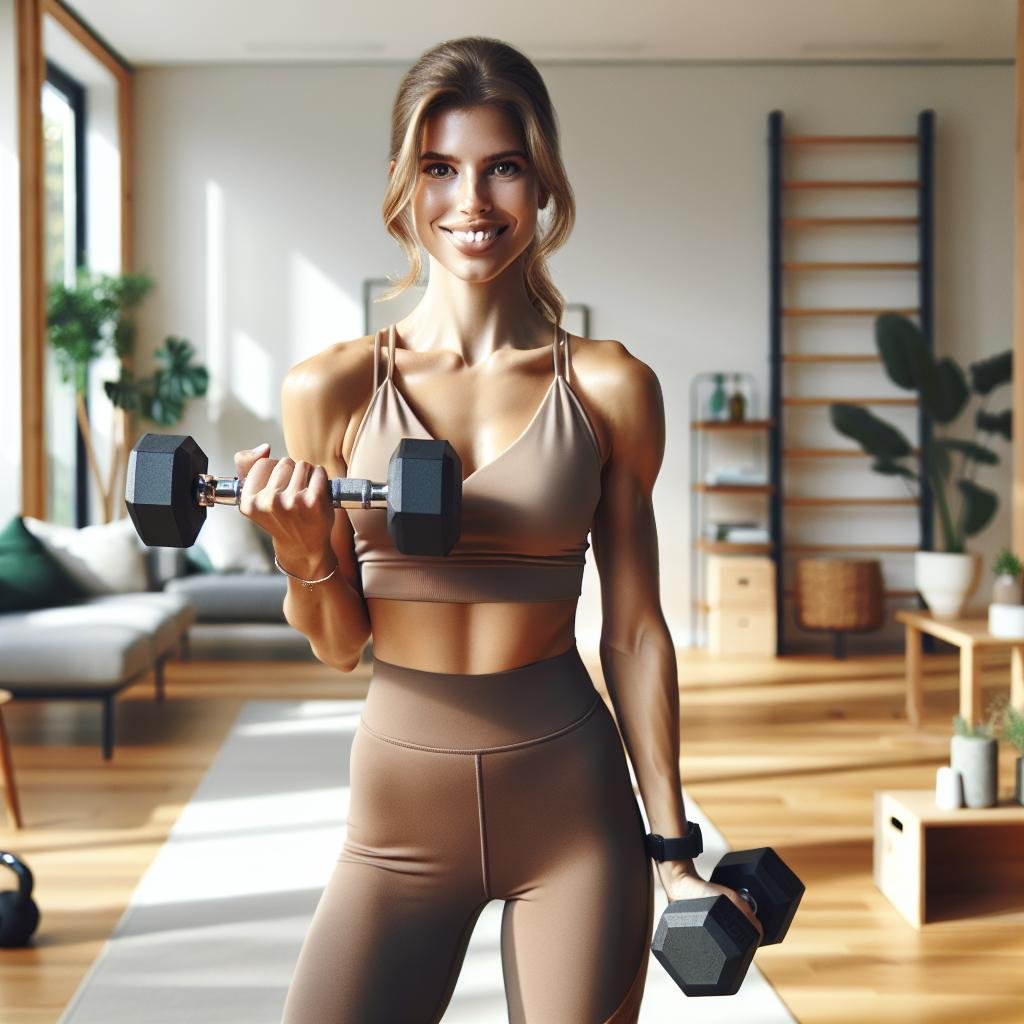
Free Weight Exercises Guide | Essential Tips for Every Muscle
Free weights are the cornerstone of effective strength training. Unlike machines that guide your movement, free weights require your muscles to work harder for stability and control. This comprehensive guide will walk you through essential free weight exercises targeting every major muscle group, proper form techniques, and programming tips to maximize your results.
Whether you’re a beginner just starting your fitness journey or an experienced lifter looking to refine your routine, mastering these fundamental movements can transform your physique and boost your functional strength.
Why Free Weights Should Be Your First Choice
Free weights offer unparalleled benefits that machine-based workouts simply can’t match. When you lift a dumbbell, barbell, or kettlebell, your body must engage stabilizing muscles to control the weight through space.
This natural movement pattern more closely mimics real-life activities, making free weights superior for developing practical, usable strength. Let’s explore the key advantages:
- Greater muscle activation across multiple joints and planes of movement
- Improved balance, coordination, and proprioception
- More efficient calorie burn compared to machine exercises
- Versatility to perform hundreds of exercises with minimal equipment
- Enhanced hormone response, particularly growth hormone and testosterone
According to a 2016 study in the Journal of Strength and Conditioning Research, free weight exercises typically activate more muscle fibers than their machine-based counterparts, leading to greater strength gains over time.
Essential Equipment for Free Weight Training
Before diving into specific exercises, let’s cover the basic equipment you’ll need. The beauty of free weight training is its simplicity – you don’t need an extensive home gym to get started.
Dumbbells
These versatile weights allow for unilateral training (working one side at a time) and accommodate a wide range of exercises. For beginners, a set of light, medium, and heavy dumbbells is ideal.
Barbells
Perfect for compound movements like squats, deadlifts, and bench presses, barbells allow you to progress to heavier weights as you build strength. A standard Olympic barbell weighs 45 pounds (20kg).
Kettlebells
With their unique shape and handle, kettlebells are excellent for dynamic, explosive movements that build power and cardiovascular fitness simultaneously.
Weight Plates
These attach to barbells and some machines. A variety of weights allows for precise loading and progressive overload – a key principle for continued strength gains.
Upper Body Free Weight Exercises
Building a strong upper body enhances posture, increases pushing and pulling power, and creates that coveted V-taper physique. Here are the fundamental movements you should master:
Chest Exercises
Dumbbell Bench Press
This classic chest builder also engages the shoulders and triceps while allowing greater range of motion than its barbell counterpart.
- Lie on a flat bench holding dumbbells directly above your chest
- Lower the weights with control until your elbows form 90-degree angles
- Press back up, focusing on squeezing your chest at the top
- Keep your feet flat on the floor and maintain a slight arch in your lower back
Incline Dumbbell Flyes
This isolation movement targets the upper chest fibers and improves shoulder mobility.
- Set a bench to a 30-45 degree incline
- Hold dumbbells above your chest with a slight bend in your elbows
- Lower the weights in an arc motion until you feel a stretch across your chest
- Return to the starting position, maintaining the same elbow angle throughout
Back Exercises
Bent-Over Barbell Row
This powerful back builder targets the lats, rhomboids, and rear deltoids while engaging the core for stability.
- Stand with feet shoulder-width apart, holding a barbell with an overhand grip
- Hinge at the hips until your torso is nearly parallel to the floor
- Pull the barbell toward your lower ribcage, keeping elbows close to your body
- Lower with control and repeat, maintaining a neutral spine throughout
Single-Arm Dumbbell Row
This unilateral exercise prevents strength imbalances while building a stronger, thicker back.
- Place one knee and hand on a bench, opposite foot on the floor
- Hold a dumbbell in your free hand, arm fully extended
- Pull the weight up toward your hip, keeping your elbow close to your body
- Lower with control and repeat before switching sides
Shoulder Exercises
Overhead Press
Whether performed with a barbell or dumbbells, this compound movement builds impressive shoulder strength and stability.
- Stand with feet shoulder-width apart, holding weights at shoulder height
- Brace your core and press the weight overhead until arms are fully extended
- Lower with control back to shoulder level
- Avoid excessive arching in your lower back during the movement
Lateral Raises
This isolation exercise specifically targets the medial deltoids, creating that sought-after shoulder width.
- Stand holding light dumbbells at your sides, palms facing in
- Raise the weights out to the sides until arms are parallel to the floor
- Maintain a slight bend in your elbows throughout the movement
- Lower slowly and repeat, avoiding momentum or swinging
Lower Body Free Weight Exercises
A strong lower body is the foundation for overall strength and athletic performance. These exercises will build powerful legs and a resilient posterior chain.
Barbell Back Squat
Often called the king of exercises, the back squat builds serious lower body strength while stimulating anabolic hormone release.
- Position a barbell across your upper back (not on your neck)
- Stand with feet slightly wider than shoulder-width, toes pointed slightly outward
- Brace your core and squat down by pushing your hips back and bending your knees
- Descend until thighs are at least parallel to the floor
- Drive through your heels to return to standing, keeping your chest up throughout
Romanian Deadlift
This hip-hinge movement targets the hamstrings and glutes while teaching proper posterior chain activation.
- Stand holding a barbell against your thighs, feet hip-width apart
- Push your hips back while lowering the bar along your legs
- Keep a slight bend in your knees and maintain a flat back
- Lower until you feel a stretch in your hamstrings (typically mid-shin)
- Drive your hips forward to return to standing, squeezing your glutes at the top
Bulgarian Split Squat
This unilateral exercise exposes and corrects strength imbalances while building single-leg stability.
- Stand about two feet in front of a bench, holding dumbbells at your sides
- Place the top of one foot on the bench behind you
- Lower your body by bending your front knee, keeping your torso upright
- Descend until your front thigh is parallel to the floor
- Push through your front heel to return to the starting position
- Complete all reps on one side before switching legs
Goblet Squat
Perfect for beginners, this squat variation promotes proper form while still providing an effective lower body stimulus.
- Hold a dumbbell or kettlebell close to your chest with both hands
- Stand with feet slightly wider than shoulder-width apart
- Sit back and down as if sitting into a chair
- Keep your chest up and elbows between your knees as you descend
- Push through your heels to stand back up
Core-Focused Free Weight Exercises
A strong core is essential for transferring force between your upper and lower body and preventing injury during heavy lifts.
Weighted Russian Twist
This rotational exercise strengthens the obliques and improves rotational power.
- Sit on the floor holding a weight (dumbbell, kettlebell, or plate) at chest level
- Lean back slightly, lifting your feet off the floor (bend knees for easier variation)
- Rotate your torso to touch the weight to the floor on one side
- Rotate to the opposite side in a controlled manner
- Keep your spine long and chest up throughout the movement
Farmer’s Carry
This functional movement builds total-body stability and grip strength while challenging your core.
- Hold heavy dumbbells or kettlebells at your sides
- Stand tall with shoulders back and core engaged
- Walk forward with controlled steps for distance or time
- Maintain good posture throughout – no leaning or hunching
Programming Your Free Weight Workout
Now that you know the essential exercises, let’s discuss how to structure them into an effective workout program.
For Beginners (0-6 months of training)
- Frequency: 2-3 total body workouts per week
- Sets: 2-3 per exercise
- Reps: 10-15 per set
- Rest: 60-90 seconds between sets
- Focus on mastering form with lighter weights before progressing
For Intermediate Lifters (6 months to 2 years)
- Frequency: 3-4 workouts per week, possibly split by body part
- Sets: 3-4 per exercise
- Reps: 8-12 for upper body, 10-15 for lower body
- Rest: 90-120 seconds between sets
- Incorporate progressive overload by increasing weight regularly
For Advanced Lifters (2+ years)
- Frequency: 4-6 workouts per week, typically with body part splits
- Sets: 4-5 per exercise
- Reps: Vary between strength (4-6), hypertrophy (8-12), and endurance (15+) phases
- Rest: 2-3 minutes for heavy compound movements, 60-90 seconds for isolation work
- Consider periodization strategies to prevent plateaus
Form and Safety Tips
Free weight training delivers incredible benefits when performed correctly, but poor form can lead to injury. Follow these crucial guidelines:
- Start with lighter weights to master proper movement patterns
- Breathe properly – exhale during the effort phase, inhale during the return
- Maintain neutral spine alignment during all exercises
- Use a spotter for heavy lifts, especially bench press and squats
- Warm up thoroughly before each workout with dynamic stretches and lighter sets
- Progress gradually – aim for 5-10% weight increases when ready
- Listen to your body and distinguish between productive discomfort and pain
Sample Total-Body Free Weight Workout
Here’s a balanced routine that hits all major muscle groups using only free weights:
- Barbell Back Squat: 3 sets of 10 reps
- Dumbbell Bench Press: 3 sets of 10 reps
- Bent-Over Barbell Row: 3 sets of 10 reps
- Romanian Deadlift: 3 sets of 10 reps
- Overhead Press: 3 sets of 10 reps
- Bulgarian Split Squat: 2 sets of 10 reps per leg
- Weighted Russian Twist: 2 sets of 20 total reps (10 per side)
- Farmer’s Carry: 2 sets of 40-50 steps
Rest 90 seconds between sets. Perform this workout 2-3 times per week with at least one rest day between sessions.
Common Mistakes to Avoid
Even experienced lifters can fall prey to these common free weight training errors:
- Ego lifting – using weights that are too heavy for proper form
- Neglecting posterior chain exercises (back, hamstrings, glutes)
- Inconsistent range of motion from rep to rep
- Poor breathing patterns – holding breath or breathing at incorrect times
- Training the same muscle groups too frequently without adequate recovery
- Relying on momentum rather than controlled muscle contraction
Conclusion
Free weight training stands as the gold standard for building functional strength, muscle mass, and athletic performance. By mastering the fundamental movements outlined in this guide, you’ll develop a balanced physique that not only looks impressive but performs exceptionally well in daily life and athletic endeavors.
Remember that consistency trumps perfection – even two or three quality free weight sessions per week can transform your body over time. Start with proper form using manageable weights, then gradually increase the challenge as your strength improves.
What free weight exercise has given you the best results? Share your experience or questions about implementing these movements into your routine – your journey might inspire someone else just getting started!


